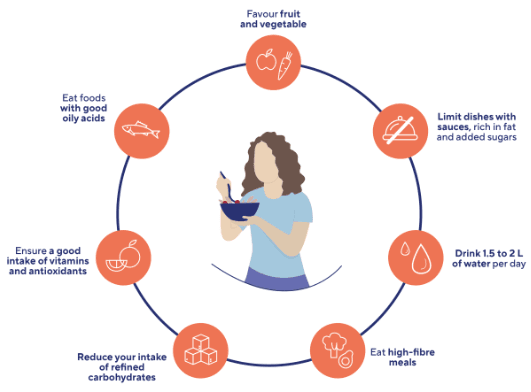Impact of obesity on knee osteoarthritis
Obesity: definition and calculation of BMI
Obesity rates have skyrocketed since 1970 and are expected to reach a staggering 1 billion people by 2030(1).
The term "overweight" is defined as having a body mass index (BMI) greater than 25 kg/m², while the term “obesity” is defined as having a BMI above 30 kg/m²(4).
To know if you are concerned by obesity, you can calculate your BMI here!
However, BMI is not always the best measure for everyone. For example, it may not accurately reflect body fat in adults with high muscle mass, such as athlete, or in people over 65. Additionally, for those with a BMI below 35 kg/m², measuring waist-to-height ratio can help better assess health risks(8).
How does obesity affect knee osteoarthritis?
But how exactly is obesity related to knee OA? The joints of the lower body, especially the hips and knees, bear the weight of our whole body. For those who are overweight or obese, this pressure on the knees increases significantly(2,3), degrading the cartilage and triggering inflammation(1,6), making knee OA more painful and faster progressing(4). Here's a striking statistic: for every 5-point increase in BMI, the risk of developing knee OA goes up by 35%(1).
Did you know that knee OA accounts for four-fifths of the global OA burden(4)! In fact, Knee OA is even becoming more common even among younger people(2,5). Obesity is a major culprit, as people who are obese are 5 to 7 times more likely to develop knee OA compared to those with a normal weight(1,3). This increased risk is due to several factors. For example, the extra weight can cause knee malalignment and hyperextension(3), as well as injuries like meniscal tears or anterior cruciate ligament tears(2). For instance, higher thigh girth in obese individuals can lead to the thighs touching and causing discomfort, prompting them to bend the knee towards the outside, putting uneven pressure on the knees which leads to further stress and damage(4).
Muscle weakness, particularly in the quadriceps, is another issue linked to obesity. Weaker muscles can result in knee instability, which exacerbates the problems caused by OA(4).
Beyond Weight-Bearing Joints
Interestingly, OA is more prevalent in the hands and wrists joints of obese individuals, even though these joints don't bear the body's weight(1,3,4). The culprit? Fat cells, which are larger and more numerous in obese people, release molecules that cause inflammation, exacerbating OA and contributing to cartilage erosion, even in non-weight bearing joints(1,3,4,5).
Other obesity-related conditions, such as type 2 diabetes and hypertension, also impact OA likelihood by promoting inflammation and impairing the repair mechanisms of cartilage damage(2,3,4).
The Weight Loss Solution
But there's hope! While OA cannot be cured (except through joint replacement surgery in severe cases)(1), losing weight can significantly reduce the risk, alleviate pain, restore mobility, and decrease inflammation(1,4).
Did you know? Adopting a healthy lifestyle with a balanced diet (like the Mediterranean diet) and regular exercise (aerobic, strengthening, and/or aquatic) can help manage your weight and improve your joint function, especially the knee joint(2,3,4,7).

Wearing a knee brace can also help to improve pain and stiffness during exercise and is recommended by the scientific community(4).
So, if you're carrying a few extra pounds, it's time to lighten the load – not just for your waistline but also for your joints! Embrace a healthier lifestyle and reduce your risk of developing this debilitating condition.
Remember, prevention is key, and a little weight loss can go a long way in keeping your joints happy and pain-free!
- Sobieh BH, El-Mesallamy HO, Kassem DH. Beyond mechanical loading: The metabolic contribution of obesity in osteoarthritis unveils novel therapeutic targets. Heliyon. 2023 Apr 25;9(5):e15700.
- Mocanu, V.; Timofte, D.V.; Zară-Dănceanu, C.-M.; Labusca, L. Obesity, Metabolic Syndrome, and Osteoarthritis Require Integrative Understanding and Management. Biomedicines 2024, 12, 1262.
- Sampath SJP, Venkatesan V, Ghosh S, Kotikalapudi N. Obesity, Metabolic Syndrome, and Osteoarthritis-An Updated Review. Curr Obes Rep. 2023 Sep;12(3):308-331.
- Shumnalieva R, Kotov G, Monov S. Obesity-Related Knee Osteoarthritis-Current Concepts. Life (Basel). 2023 Jul 28;13(8):1650.
- Park D, Park YM, Ko SH, Hyun KS, Choi YH, Min DU, Han K, Koh HS. Association of general and central obesity, and their changes with risk of knee osteoarthritis: a nationwide population-based cohort study. Sci Rep. 2023 Mar 7;13(1):3796.
- Sophocleous A. The Role of Nutrition in Osteoarthritis Development. Nutrients. 2023 Oct 12;15(20):4336. doi: 10.3390/nu15204336.
- Pavlovic N, Naylor J, Boland R, Harris IA, Flood VM, Genel F, Gao M, Hackett D, Vleeskens C, Brady B. Why do some people with osteoarthritis and obesity awaiting hip or knee arthroplasty achieve successful weight management? A qualitative study. J Clin Nurs. 2023 Oct;32(19-20):7543-7559.
- NICE. Obesity: identification, assessment and management ; 26 juil 2023.


